
Date: 2025-10-21 Page is: DBtxt003.php txt00024129
THE UKRAINE WAR
PUTIN NEEDS TO BE HELD ACCOUNTABLE !!!!!!
Vladimir Putin's Inhumane Blueprint to Terrorize Civilians
in Chechnya, Syria ... and now Ukraine
PUTIN NEEDS TO BE HELD ACCOUNTABLE !!!!!!
Vladimir Putin's Inhumane Blueprint to Terrorize Civilians
in Chechnya, Syria ... and now Ukraine
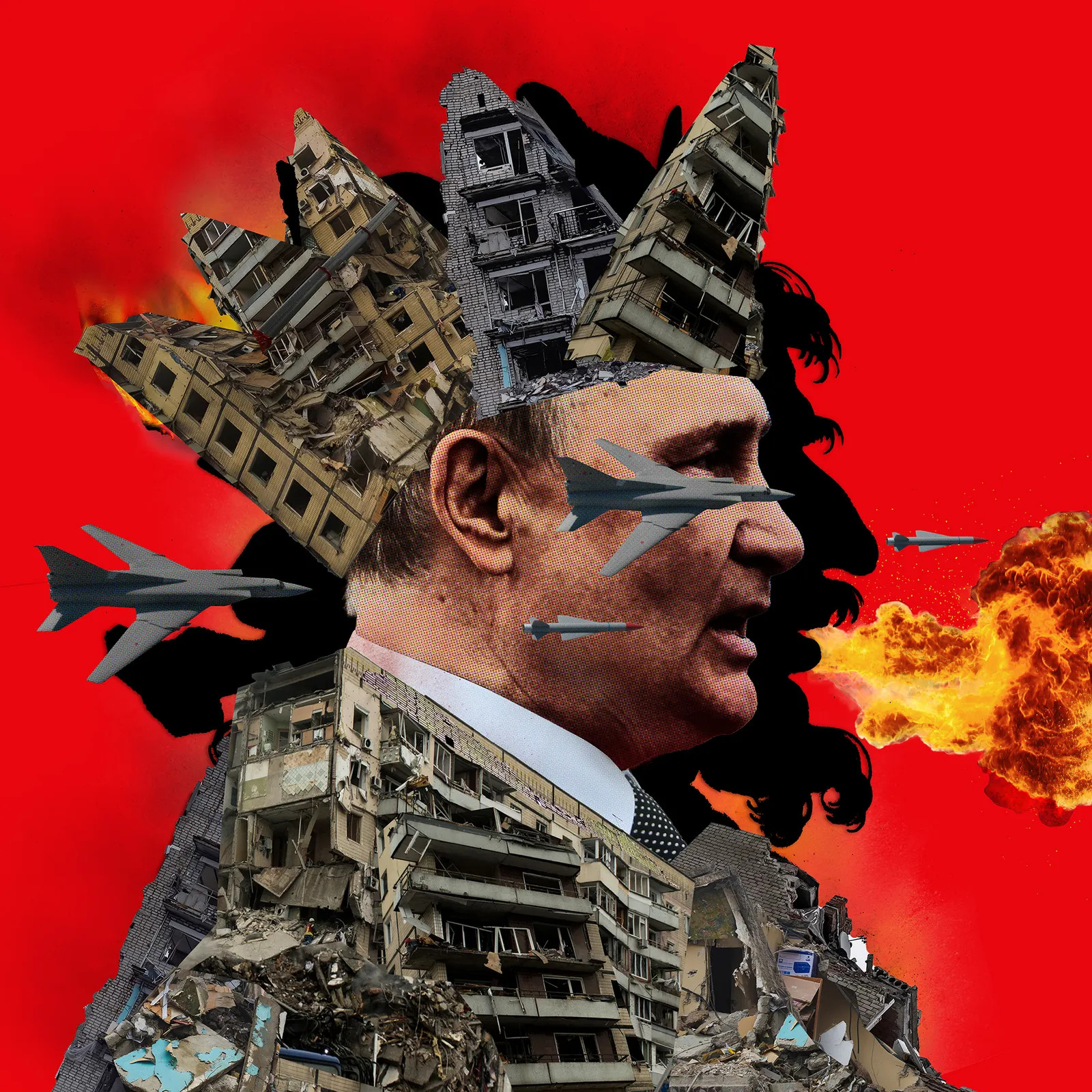
ILLUSTRATION BY DOUG CHAYKA.
Original article: https://www.vanityfair.com/news/2023/02/vladimir-putin-chechnya-syria-ukraine
Peter Burgess COMMENTARY
I was born in the UK in 1940. My family lived in the outskirts of London and we were subject to German bombing by the Luftwaffe and then later the V1 and V2 rockets. I was too young to be scared. I did not know that people got inured and killed though I did understand that windows got blown out, there were holes in roofs and sometime whole walls were crumbled. I can only imagine what my parents went through and the stress they endured. My parents built an 'air-raid shelter' in the garden ... a reinforced concrete box about 3 feet below grade with walls and roof about 3 feet thick and about 7 feet by 7 feet by 7 feet of interior space ... enough room for two double bed bunk style sleeping spaces. This is where our family slept together with our immediate neigbors for most of the war.
I am remembering all of this because of what is now going on in Ukraine. Frankly, I have no patience for the folk who want to end the war and have peace now with little or no accounting for the atrocities that have been perpetrated by Putin and his enablers. As a schoolboy in the late 1940s and 1950s I got to know a lot about what had happened in the war and I am not very tolerant of some of the rewrite that has been going on in some quarters during the last few years including some in the USA who want immediate 'appeasement' in order to have 'peace'. I want peace more than most, but not 'at any price' ... rather I am fully in support of Ukraine and their goal of recovering all their terrirory in the East of Ukraine and Crimea.
I don't know a lot about the Nuremberg Trials after WWII, but something along those lines is a must. Invasion must not be tolerated. There are a lot of countries around the world which have bigger and more powerful neighbors who must not be empowered to annex territory simply because they want to and have a bigger army. I was working in Africa when the UK deployed the Royal Navy to protect the Falkland Islands ... a British territory near Argentina ... from an attack ny the Argentine military. I did not expect it, but all the Africans I was working with were supportive of the British response, because nearly all of them had potentially belligerent neigbbors with big armies that would happily start to redraw borders in Africa if territorial integrity is no longer somewhat sacrosanct.
Putin ... and the Russian Federation ... must be held to account.
Peter Burgess
VLADIMIR PUTIN’S INHUMANE BLUEPRINT TO TERRORIZE CIVILIANS IN CHECHNYA, SYRIA—AND NOW UKRAINE
A year into the war, a veteran conflict reporter presents a withering assessment of the Russian leader’s strategy of systematic carnage in three decimated cities: Grozny, Aleppo, and Mariupol.
WRITTEN BY JANINE DI GIOVANNI
Researchers Angelina Kariakina, Kostiantyn Korobov, and Viktoria Novikova of the Reckoning Project contributed to this story.
FEBRUARY 23, 2023
Vladimir Putin became the prime minister of Russia in August 1999, then president in March 2000. And in the 24 years since, the list of wars conducted on his watch amounts to a catalog of human misery. They stretch from the Second Chechen War to a military incursion into Georgia, from the annexation of Crimea to Russia’s lockstep allegiance with Syrian president Bashar al-Assad to destroy that country’s opposition forces. That roster of calamity has culminated, of course, in the war that has mobilized Europe against Putin’s war machine—the devastating invasion of Ukraine, which commenced a year ago this week.
In each of these bloody forays, Putin and his commanders have followed a blueprint. They have targeted the most vulnerable link at the core of each nation: its civilian population. In other ways, Putin, even as he has tried to revitalize Russian military power in ways reminiscent of the days of Stalin, has expanded his battle methods to include new capabilities. In the war in Ukraine, for example, he has mobilized online operatives in a relentless information war against open democracies. And in recent months, his military leaders have relied on brutal mercenaries like the Wagner Group, which this month released another one of their purported “execution” videos, supposedly showing an alleged Russian defector crumpling to the ground after a masked man wielding a sledgehammer apparently smashes the victim’s head against a wall. The Wagner Group’s ranks reportedly include former convicts who are deemed “meat” by some Ukrainian soldiers because of how they advance like cannon fodder into battle.
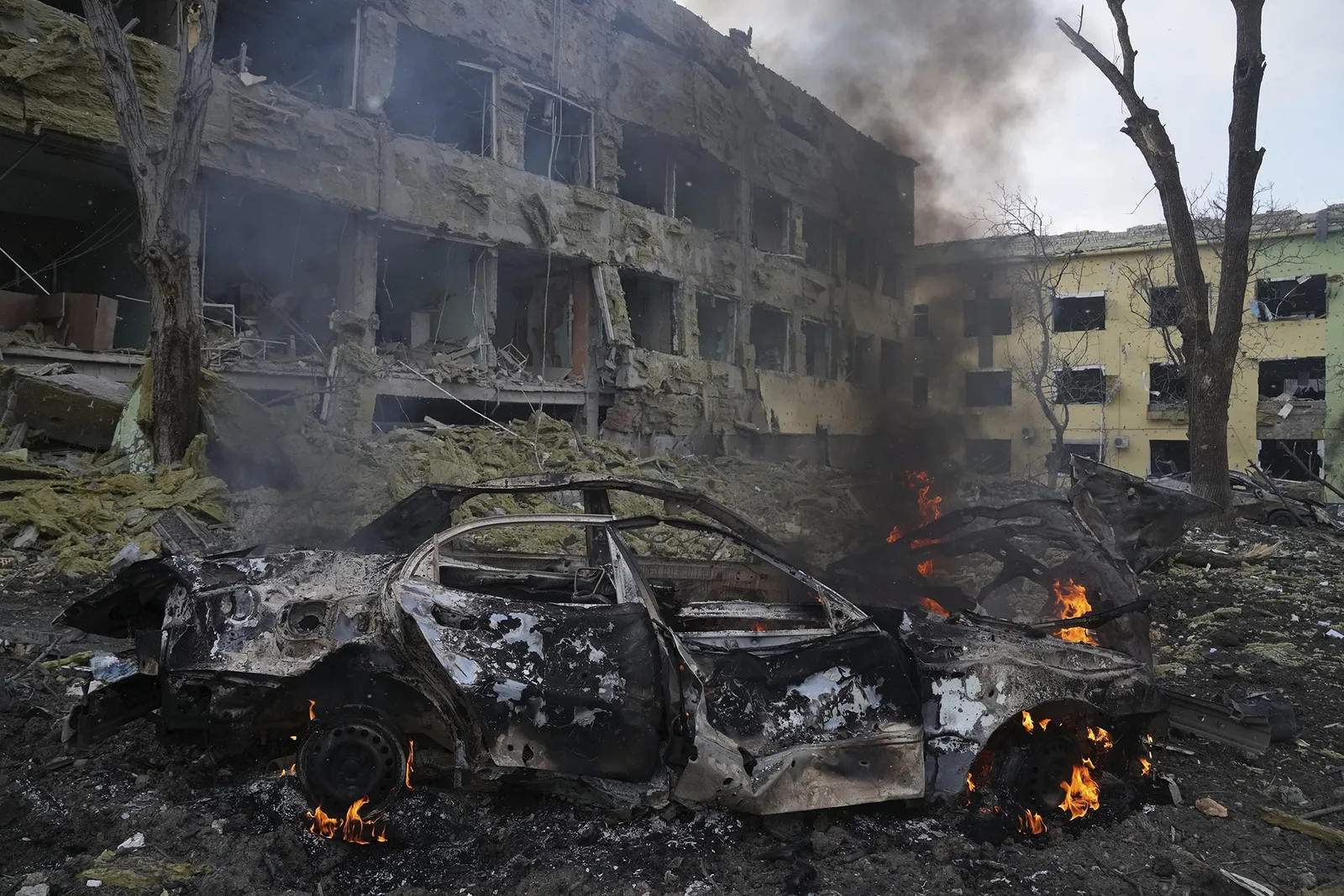
A car burns at the side of a maternity hospital that was damaged by shelling in Mariupol, Ukraine, March 2022. BY EVGENIY MALOLETKA/AP.
As a correspondent, I have covered three of these wars up close—in Chechnya, Syria, and, now, Ukraine. As a human rights activist, I cofounded the Reckoning Project last year, where I serve as executive director. Our main role has been to gather testimonies from Ukrainian eyewitnesses in order to build legal cases, not only against Russian soldiers committing war crimes—which I chronicled in a recent VF story—but also against Putin and the Kremlin. Scrutinizing his methods from past wars, especially his deadly mass assaults on citizens in cities and towns, is a way to understand Putin’s current modus operandi.
In the three Russian wars I have reported on, three cities in particular seem to have borne the most focused brunt of Putin’s wrath.
When I study the destruction of the Ukrainian port city of Mariupol—which endured a painful three-month siege that cut off food, water, and electricity to civilians before falling into Russia’s hands in May 2022—I see echoes of Aleppo (in Syria), and of Grozny (in Chechnya). Mariupol, a coastal city on the Sea of Azov, was once famous for trade and higher education. But the place has suffered so terribly in the past year that the town, formerly known as Zhdanov, is now referred to across the country as one of the “Hero Cities” of Ukraine.
HE USES FEAR, BRUTE FORCE, SECRECY, INTIMIDATION, AND COMPLETE CONTROL TO VANQUISH HIS ENEMIES.
Aleppo had been a stop on the ancient Silk Road, a place renowned for its beauty and grace. Over the course of many months, it was reduced to rubble, with more than 31,000 civilians killed, many during a final stand against Putin and Assad.
Grozny, distinguished for its oil deposits, was founded in the 1800s as a fortress city, where a soldier named Leo Tolstoy was once stationed. In the early 21st century, however, after Grozny succumbed at last to Russian forces, the United Nations designated the Chechen capital the “most destroyed city on earth.”
To comprehend Putin’s seeming thirst for territory and his ability to tolerate death and destruction, you have to understand his underlying motives. And from my reporting on military campaigns and the local populations in these three locales, I have come to an unsettling conclusion.
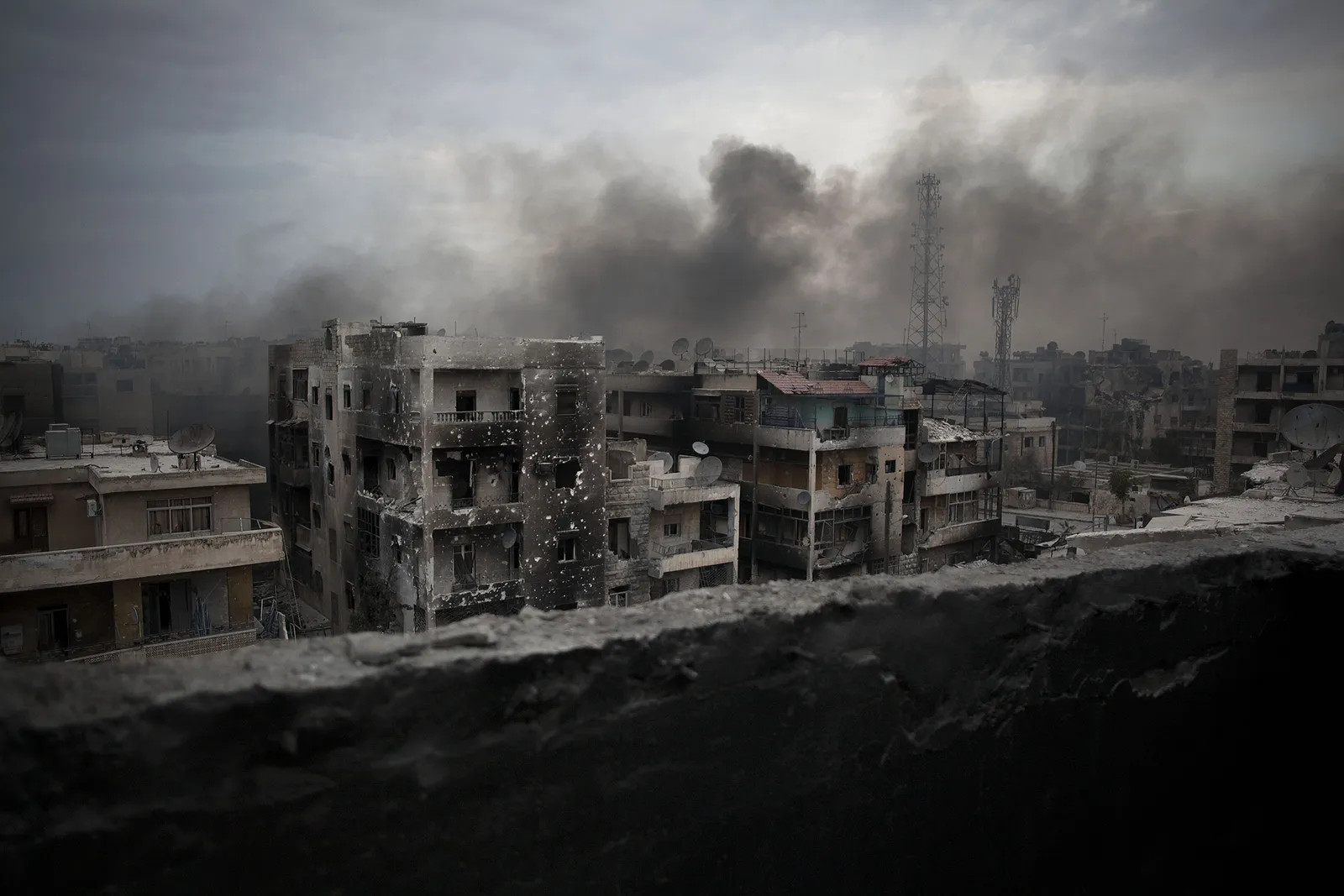
Smoke rises over Aleppo’s Saif Al Dawla district, Syria, 2012. BY MANU BRABO/AP PHOTO.
I believe Vladimir Putin is motivated by a desire to retain power, privilege, and leverage at all costs. A former spymaster trained in the Soviet surveillance state, he employs methods for remaining Russia’s supreme leader that are rooted in his background as an intelligence agent. He perceives those around him warily; his paranoia is the handmaiden of his success. He uses fear, brute force, secrecy, intimidation, and complete control to vanquish enemies. Unsettled by the 1991 collapse of the Soviet Union (which he has called a “genuine tragedy…. the greatest geopolitical catastrophe of the century,” he has apparently come to see some of his neighboring nations as would-be adversaries and, therefore, potentially ripe for the taking.
Because he believes in brute force—and considers fear to be a force multiplier—he attempts to use brute force to instill raw fear in those who are most easily frightened: unarmed innocents. And as a result, he appears to be driven to attack civilians with indiscriminate bombardments, hoping to destroy the essential infrastructures of towns and cities—hospitals, schools, electrical grids, and water supplies—to weaken morale and crush the will of the population.
In seeking his possible endgames of winning territory or decimating an opponent, his methods have been almost medieval in nature. To conquer, he must destroy and, in the process, kill, kill, and then kill some more. The consequence, in many cases, is to drive people to the edge of madness.
In Ukraine, however, he may have met his match, taking on an opponent that exhibits neither fear nor an inclination to bow to brute force.
MARIUPOL
On March 16, 2022, a few weeks into Russia’s invasion of Ukraine, warplanes attacked the Donetsk Academic Regional Drama Theater, an elegant white building which was being used as Mariupol’s main civilian bomb shelter. The theater, rocked by the airstrike, collapsed upon its inhabitants.
At first, the authorities could only speculate about how many people died and were buried in the ruins. Government sources believed the toll was close to 300. But in May, an independent study done by the Associated Press’s War Crimes Unit (which collaborates with the Reckoning Project) found evidence that the attack was far deadlier than estimated, claiming closer to 600 lives both in and outside the building. This meant that the bombing of the Mariupol theater was the single most deadly against civilians in the war.
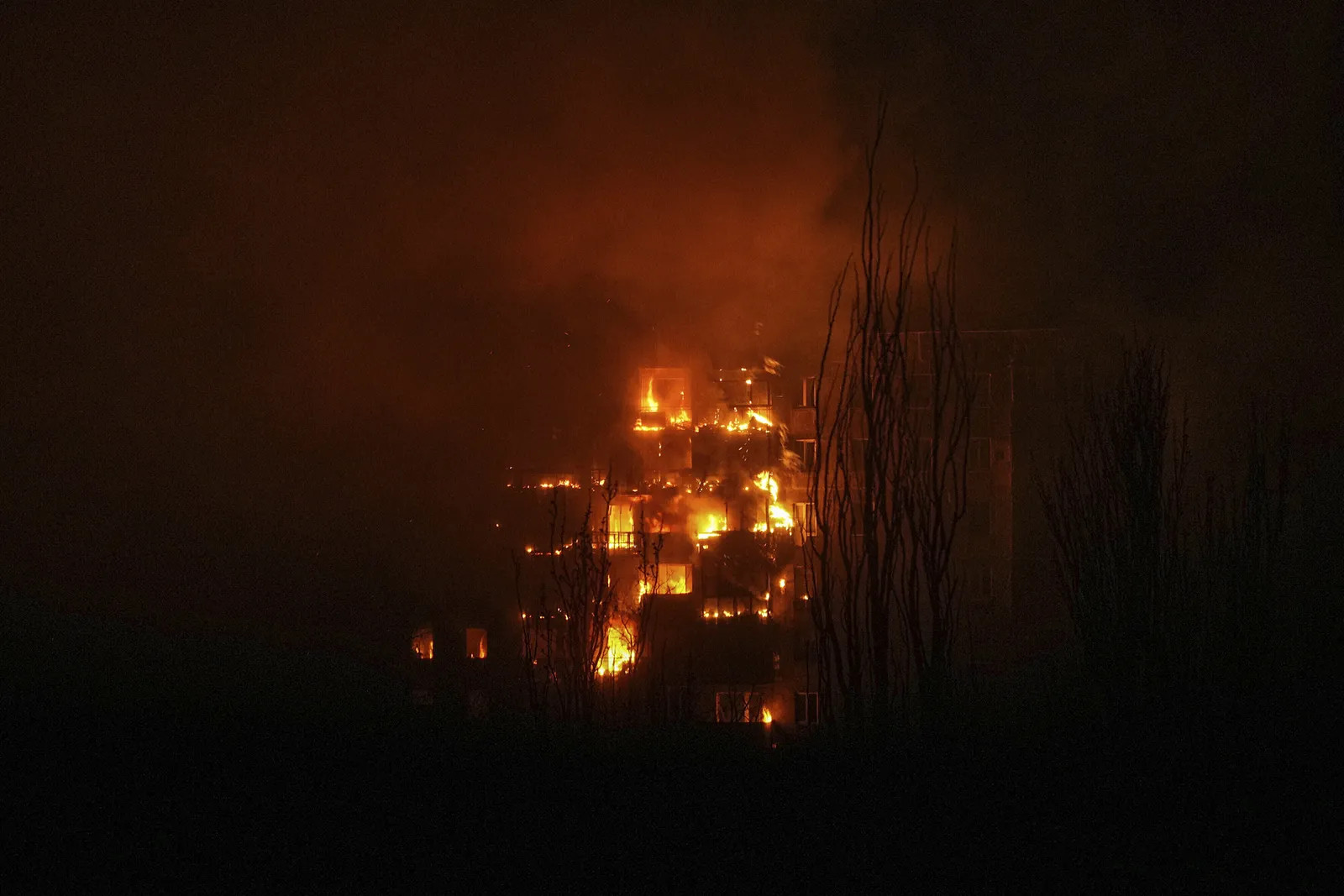
A fire burns at an apartment building after it was hit during the shelling of a residential district in Mariupol, Ukraine, March 2022.BY EVGENIY MALOLETKA/AP PHOTO.
In December 2022, according to the BBC, which quoted a local source, the Russian authorities in charge began reducing what remained of the theater to rubble in an apparent attempt to eliminate any traces of their war crimes. Researchers from the Reckoning Project spoke to many of the civilians who survived. Most of these witnesses estimated that before that attack, around 1,000 of their neighbors had cowered inside the structure, sleeping on floors, in former offices, in dressing rooms, and amid the theater seats. Many of them were children.
As the excavations continued through the winter, the Red Cross supplied food and water to the residents and workers. News reports would alert the wider world as details emerged. The theater, in a way, had become the best place to receive aid in a city that had been turned into a living hell.
WHEN THE BATTLE “MOVED TO OUR BACKYARD,” SHE SAID, THEY KNEW THEY HAD TO ESCAPE.
A Reckoning Project team member spoke to Masha, a 30-year-old who had worked in public relations and social media. She said that she had arrived at the theater on the morning of March 16 with her mother, her disabled 37-year-old sister, and three neighbors. They had been living in the corridor of a neighbor’s apartment building during the worst of the fighting, unnerved by the deafening clamor of tank and machine-gun fire outside. When the battle “moved to our backyard,” she said, and the tanks edged closer, they knew they had to escape. They had heard that the drama theater might be a refuge.
Around dawn that morning, Masha and her small entourage crept out of their building. A Russian tank opened fire at them, she remembered. They crossed onto Budivelnykiv Avenue, nearly coming face-to-face with “tanks with the letter Z”—a marking on Russian-aligned vehicles—“and we got so scared, we ran,” Masha recalled. “One tank drove out onto the avenue and began to follow us. When we came to an open area, it started shooting in our direction, and we changed our path, hiding [for a time], and then running toward the theater.” It took them an hour or more to reach their safe haven, dodging fire along the way.
Inside, the theater was dark; the electricity had been cut off. It was also chaotic, with many people crouching in the shadows. After a time, they found someone they knew, a man named Dima. He spoke rapidly: “Show your passports, we will write you down…. Here is the line for tea. Get in line…. And if you want to spend the night here, then just look for a place for yourself…. Any free place in the theater is yours, but the basement is overcrowded because obviously everyone wants to be in the basement, so look on the floors.”
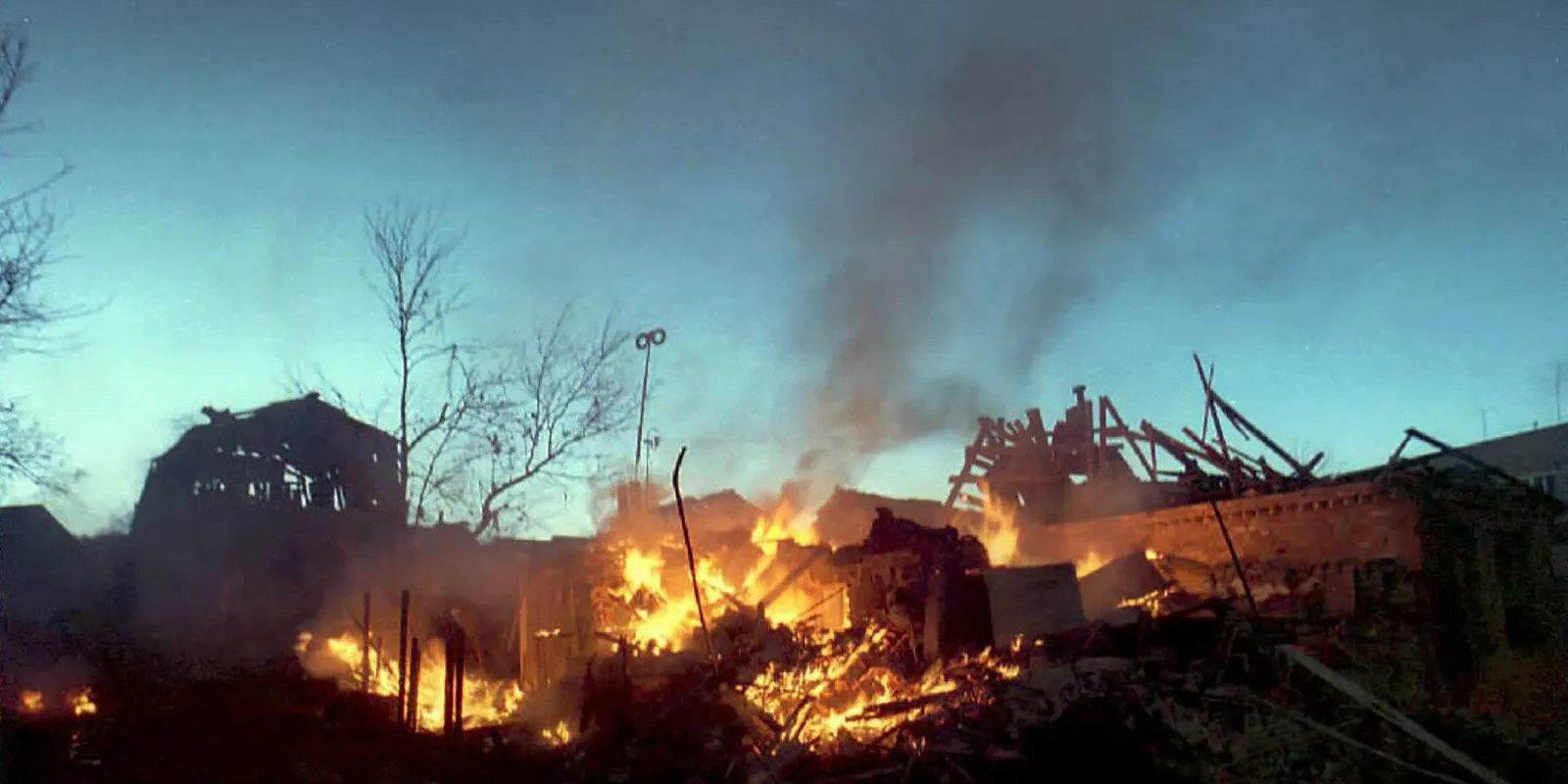
The Chechen capital, Grozny, burns after bombardments by Russian war planes in 1999. FROM STR/AFP/GETTY IMAGES.
Masha recounted that she and her family drank tea and ate for the first time in nearly six days. She then took a flashlight to explore the three floors of the building. She saw that people were sleeping in the concert hall, but also in between desks. The first and second floors were cloaked in darkness; she and her crew moved to the third floor, eventually settling themselves in the cramped corner of a balcony where she, her mother, and her sister laid blankets on the floor.
Feeling slightly better, she told her mother she would go by foot to find her uncle, who lived about 30 minutes away, in a part of the city that was being heavily shelled. Leaving the building, she walked rapidly, trying to avoid incoming fire. Then she heard a plane. “Unfortunately,” she said, “I know what a plane that drops bombs sounds like because all we did [for days and nights] was count these planes [that] dropped bombs. Usually, [a plane] has four or eight bombs—that is, four large ones, or eight slightly smaller ones. We listened and counted—yeah, one, two, three, four, it is coming back. And you think—one of those bombs will fall on your head. I heard it and the plane was very close above me.”
She was terrified, not moving too far from where she had started off. But she soon looked up and realized the pilot had already dropped his bomb load. Feeling a wave of relief, she felt safe enough to turn back onto Kuindzhi Street, the road leading to the theater square. Then, suddenly, she saw “huge pieces of the theater roof” lying on the ground. “I don’t understand what happened at all,” she thought. “I had only left 20 minutes ago.”
She ran toward the theater.
As Masha approached, she saw that the third floor—where her family had been—had started to burn. She next laid eyes on the wounded, the blood, the debris, and she heard “this cry…A lot of people were shouting at the same time. Someone was just screaming, crying out names, ‘Mom, Dad’…And I realized the theater had been bombed and that my family was there. And I’m like, here, you need to look for them.”
Masha ran around the perimeter of the building, tripping over large pieces of rubble. She saw strange, surreal sights: a woman “tearing her hair out in grief” because her son was buried in the collapse; people digging at the stones with their bare hands to dislodge people beneath the wreckage; “grandmas” walking around with head wounds.
She rushed up the stairs, screaming for her family. She found her sister covered in plaster with the family cat. She heard people calling out for one another. Others were running around senselessly. Masha and her sister, noting that the building itself was on fire, ran to the Mariupol Chamber Philharmonic nearby.
They both had lost track of their mother, but she turned out to be safe. At the time of the explosion, she had gone down to the first floor and, a while later, made it out alive. Their three neighbors, who had likewise sought refuge on the third floor, had been knocked over in the bomb blast but also survived.
At the Philharmonic, they once again tried to find space, Masha choosing a small spot one floor beneath the hall’s beautiful stained-glass windows, which she heard shatter when the Philharmonic also came under shelling at sunset. They tried to sleep, but then and there, Masha understood that she had to get out of Mariupol. They had been fortunate once. But their good fortune would inevitably run out.
Eventually, they did get out. They made their escape by minivan and on foot. As they departed the city, Ukrainian soldiers advised them about how to pass through the cordons of the Russian soldiers: “Look under your feet. Do not…leave the road because the fields are mined. Checkpoints are waiting for you ahead. Delete all photos [from your mobile phones]. Remove any Ukrainian symbols. If you are asked, say that you support Russia.”
The soldiers told them not to chat or quarrel with the Russian soldiers—and to be sure to insist that they were civilians.
They left their city in flames and traveled for nine days, through Yalta, Berdiansk, Zaporizhzhia. “There was no food, no gasoline, no cars,” Masha recalled. “There were checkpoints everywhere.”
Later, the family settled in Vilnius, Lithuania, knowing Mariupol would remain, for the foreseeable future, in Russian hands.
Masha related her story of survival with wonder and pain. She understood how fate had randomly parceled out its fortunes. They had chosen to situate themselves on the theater’s third floor. (The field kitchen and stage were disintegrated.) She had left the building only minutes before it had been attacked. She and her family had fled their home at dawn—only hours before a house nearby was shelled, killing everyone inside. She had managed to find her mother, sister, and neighbors—even her beloved cat—and then had made her way through the Russian front lines in what she called “some kind of series of coincidences,” ending up in Vilnius.
Why had the theater been attacked? The people of Mariupol had not been sequestered in a military facility. They had been hiding in plain sight in a cultural center. For days, news outlets had reported that many civilians, fearing for their lives, had sought protection there. These residents were clearly not a strategic threat. But like tens of thousands of others before them in previous Putin wars, they had become prime targets of a man and a regime using wholesale slaughter as a way of sending a message to the victims’ compatriots.
ALEPPO
During one of my many visits to Syria, a country I have covered off and on for years, I visited war-torn Aleppo. And I remember my Syrian friends talking about random coincidences—in terms similar to Masha’s. Who lives, who dies, who tells the story? Who was walking down the road at the wrong time of day and got the attention of the random piece of shrapnel? Who happened to be standing on their balcony when one of Putin’s planes dropped its ordnance? Who took the hit of Assad’s barrel bombs? Who got buried alive?
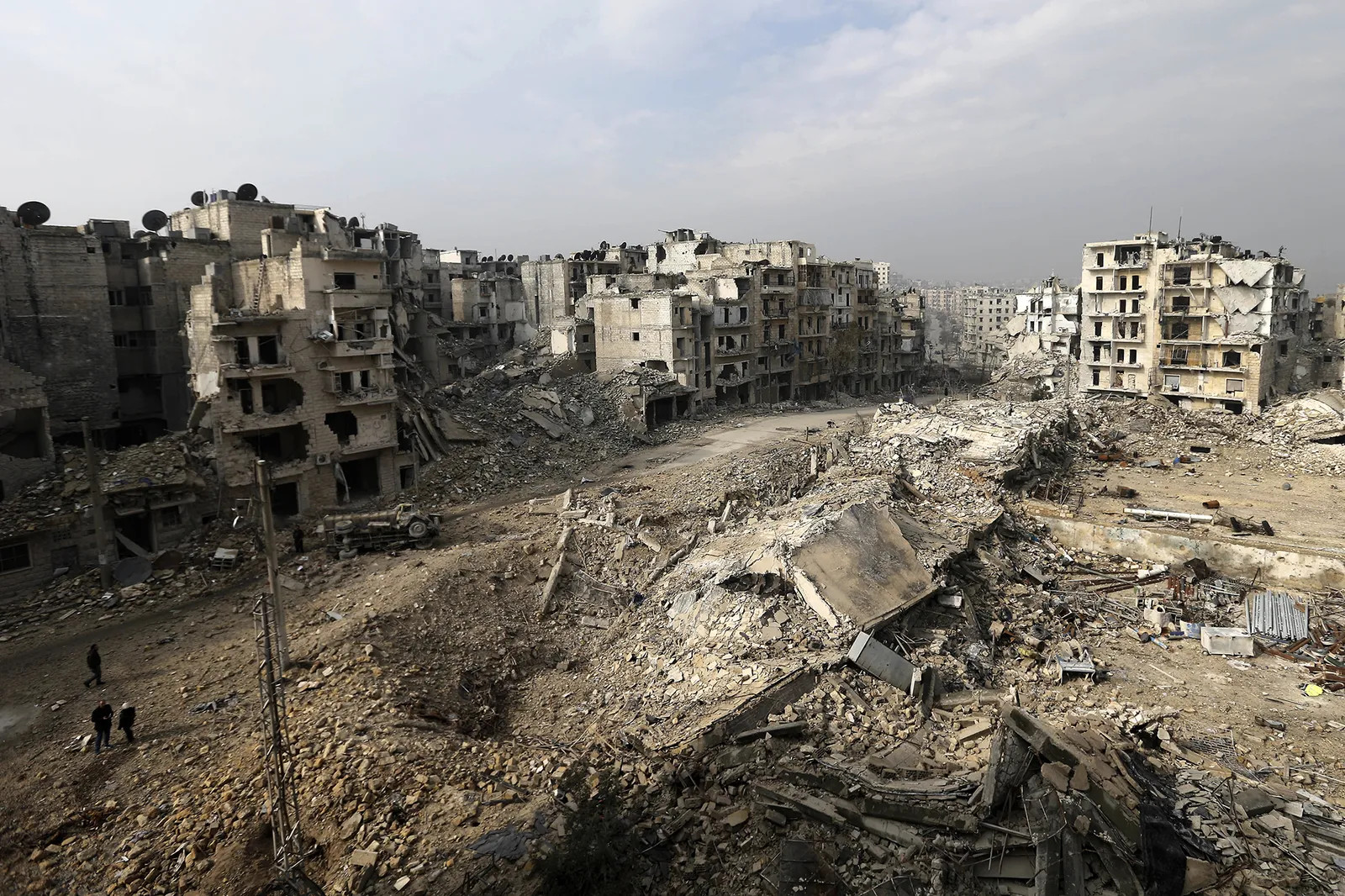
The rubble of what used to be high-rise apartment buildings in the once rebel-held Ansari neighborhood in eastern Aleppo, Syria, 2017. BY HASSAN AMMAR/AP PHOTO.
On the other hand, that roulette wheel spins both ways. Who managed to find some water, a bit of food, safe shelter? Life, in war, turns on a series of random events. And you are lucky or you are not.
At some point around 2014, after my journalist friend Steve Sotloff got kidnapped by ISIS jihadists—he was later beheaded—the risk of members of the media being kidnapped became so high that I had to stop traveling as frequently to Syria and avoid the border crossing from Turkey into Aleppo. Between trips, I sometimes communicated with friends and Syrian colleagues via WhatsApp. One day, I received a message from Ahmad, a friend who was in Darayya, a Syrian town that was being blockaded—essentially starved to death—by Assad, aided by his overseer, Putin. I always asked Ahmad mundane things. What was he eating? How bad was the shelling? He usually wrote back pragmatically. “I ate some grape leaves and a radish.”
But one day, in late autumn of 2016, he had been in a basement for several days because of the heavy bombing. He was uncharacteristically—but understandably—emotional. He sent me this message:
hi
no I’m not fine
The shelling does not stop
People (are forced to stay) in housing underground
It is revolting
I’m very tired of the war…
Stop the war…
…How can the world watch this?
I was full of shame. The world had turned away, Putin had joined the battle in 2015, and Syria was breathing its last breaths. Darayya was being intentionally deprived of food and, due to a government offensive, people were being herded into one part of the city, making them more vulnerable to bombs. There had been chemical attacks in Idlib, four hours to the north, and rescue workers had posted videos on social media of victims moaning and gasping for air.
Meanwhile, Aleppo, 40 miles from Idlib, was in a stranglehold as a raging rebel offensive sought to break it. The Syrian army’s attacks on Aleppo, sanctioned by Putin and Assad, had leveled the town, leaving residents buried alive. Both leaders seemed intent not just on conquering the city but on ravaging it, as if to make the civilians pay for not being on their side.
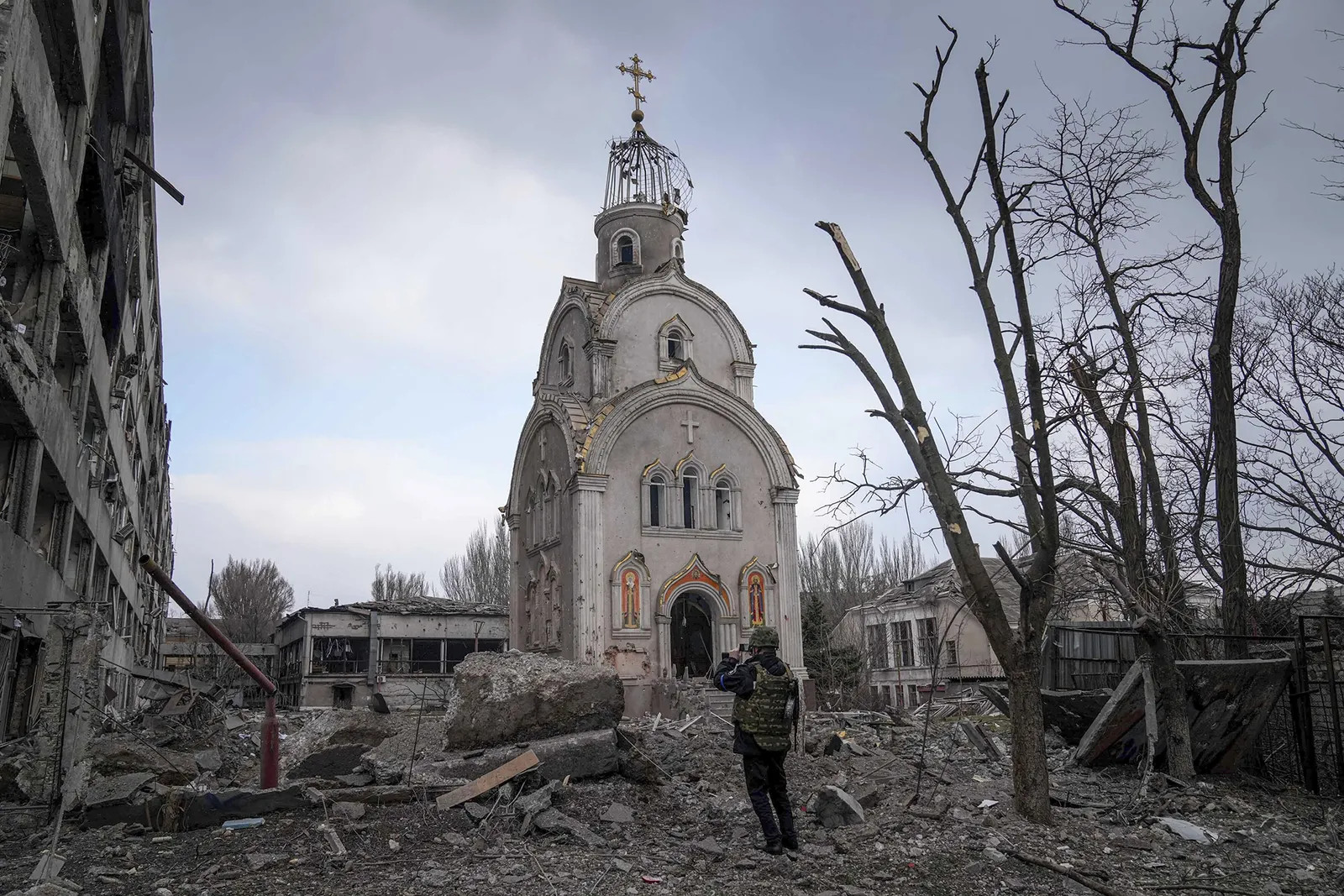
A Ukrainian serviceman photographs of a damaged church after the Russian bombardment of a residential district in Mariupol, Ukraine, March 2022. EVGENIY MALOLETKA
In Aleppo’s rebel-held eastern neighborhoods, under siege by government forces, UNICEF maintained that children made up over a third of the 300,000 residents who were then trapped in these areas. Young people were burning tires in Aleppo’s streets—creating a kind of makeshift “no-fly zone”—so that the bombers would have a more difficult time swooping in and dropping their payloads. The Russians said they wanted to open so-called “humanitarian corridors” (not unlike the one that Masha would have to navigate to find her way out of Mariupol). Such talk of corridors really seemed to be another term for ethnic cleansing. (Most of Aleppo’s population was and is Sunni Muslim; Assad himself is a member of the Alawite minority, a Shiite sect.)
At the time, there were only about 34 doctors left to tend to a third of a million people. And yet Syrian planes, as they would for years on end, kept bombing medical facilities. (For a decade, according to a study by the International Rescue Committee, the Syrian regime repeatedly targeted civilian and military hospitals, field stations, medical convoys, and the like—an unimaginably inhumane practice Russia would undertake in both Syria and Ukraine.) My friend Ibrahim, a brain surgeon mostly working in pediatric care, was operating in a basement with a headlamp. He would send me photographs of X-rays of children’s brains with shrapnel embedded in the tender tissue.
I WENT TO A CUPBOARD BEING USED AS A MEDICAL STORAGE CLOSET SO THAT I COULD CRY ALONE.
On another occasion, I was standing in a triage hospital in Aleppo where a young internist, the most senior member of the medical staff, was trying to save a tiny infant by giving her CPR. The baby had not been hit by a bomb but had an ordinary childhood illness that, in most other parts of the world, would have been easily treated. In this case, however, the parents had not been able to reach the hospital because of the shelling, and now the baby hovered between life and death.
We stood by helplessly while the young doctor worked frantically, even though the horror of the situation made it play out as if we were watching a slow-motion film. After his desperate, futile efforts, the internist halted and placed a white sheet over the baby’s face and handed the lifeless corpse to the mother, who sat, white and still, in shock.
I went to a cupboard being used as a medical storage closet so that I could cry alone. The weight of this one death had proved too much for me. I realized that this baby could have been my baby, that Aleppo could have been my city, and that the lives buried under the rubble of Putin’s bombs could have been my own.
GROZNY
I’m not a psychiatrist, but I truly believe that Putin brutalized Grozny—the capital of Chechnya—because he thought he could take it easily. Instead, the opposition troops and the people fought back. (Sound familiar?) He punished them the way an abusive husband would beat a defiant wife who resisted his attempts at humiliation: Upon meeting resistance, he walloped her even harder. In his anger and his weakness, Putin turned Grozny into a parking lot, obliterated by missiles and rockets.
The Second Chechen War started in 1999–2000 when Chechen fighters entered Russia’s Dagestan region and declared it an independent Islamic state. Russia retaliated, calling it officially “a counterterrorism operation” in the same way Putin now calls the Ukrainian war a “special military operation.” The Russian public, unless they had ways to access accounts in the independent press, would never know the extent of the cruelty launched on the small nation in the North Caucasus.
Shortly after assuming the post of Russia’s prime minister, Putin ordered the takeover of Grozny. For months, beginning in December 1999, the Russian military laid siege to the city. It was bitterly cold. Those who could run away did. But those who were too poor, too old, or too stubborn, along with the disenfranchised, the disabled, the women about to give birth—these citizens stayed behind.
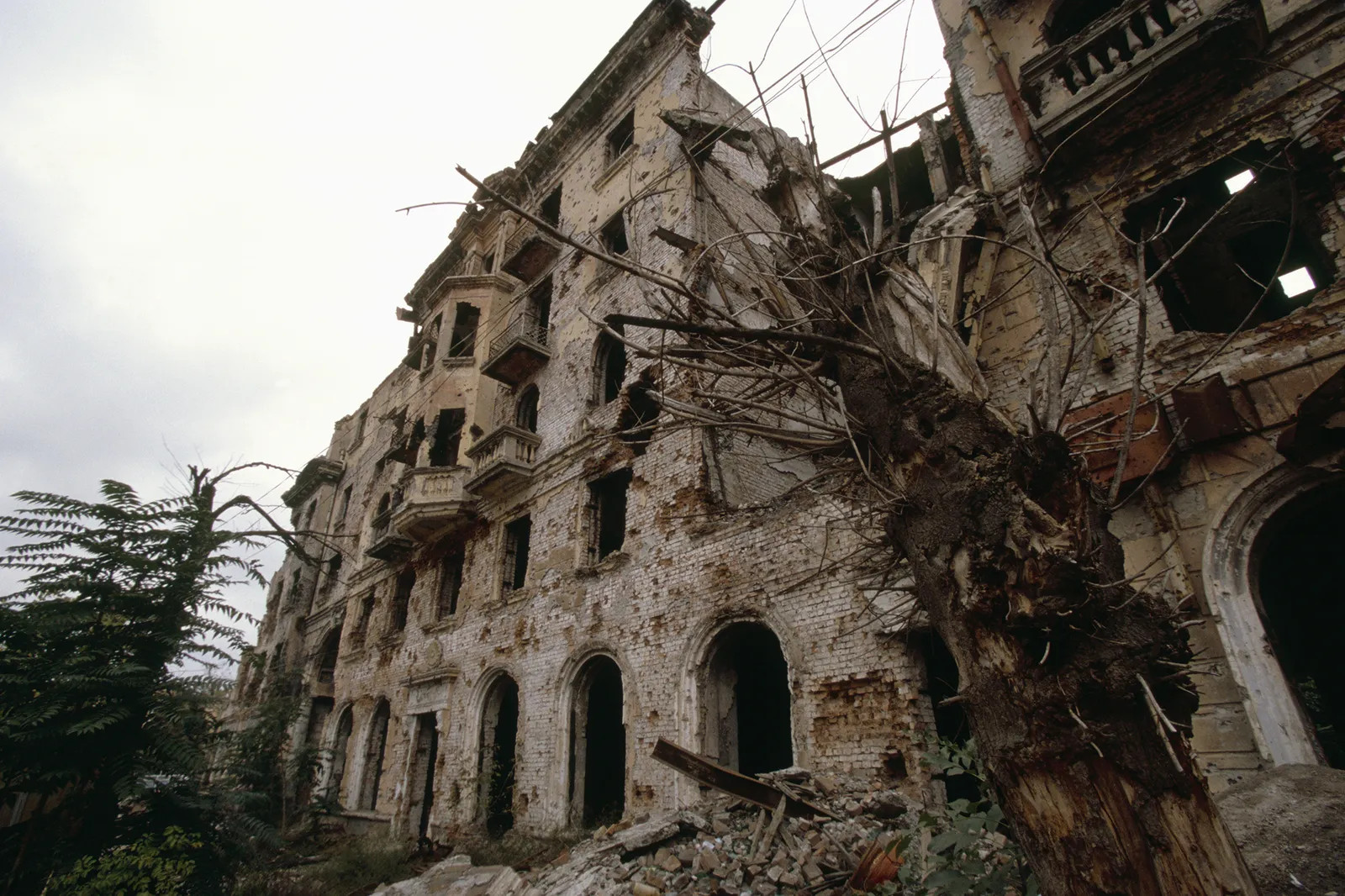
Grozny Hospital, in Grozyn, Chechnya, October 1999. BY ANTOINE GYORI/SYGMA/GETTY IMAGES.
Walking through the frozen landscape, the constant roar of war machines was apocalyptic. The streets were empty as everyone was underground in basements or vegetable cellars. Above ground, in the surrounding suburbs, street after street was laid to waste. Buildings smoldered. Putin had vowed that his military would not stop bombing Grozny until Russian troops “fulfilled their task to the end.” And so he did. By February, Grozny had finally fallen—bombed back to the Stone Age (as a US official once threatened to do to Vietnam).
Recently, the BBC’s Andrew Harding compared the fighting in Chechnya to today’s Russian troops fighting in Ukraine. “Russia’s attitude to war,” he noted, “still seems shaped by its (horrific) experiences of WW2. In other word[s], it expects war to be a vast theatre of suffering and mass casualties [and] not a place for tactical strikes and discretion. In Chechnya, the army fought accordingly. How much has changed?”
A few weeks after Grozny fell, Russian emergency workers set up a triage tent and doctors began treating some of the traumatized civilians that their Russian bombers had just injured and maimed. I remember being confused by this: You bombed them, and now you want to heal them?
I set up camp with some young Russian soldiers and doctors to try and understand the war from their perspective. We shared cough drops and vodka; cigarettes and precious lighters. This was before cell phones were ubiquitous and we talked about people back home who missed us. When I asked them for their opinions about Putin’s motives, they could not answer me, nor could they explain why they were serving in Chechnya. A couple of the youngest among them told me that their mothers did not even know where they were. The oldest man in my tent, a doctor, was philosophical about the living and the dead. “We are trying to sew people up,” he said. Yes, I argued, but first you ripped them apart. He sat next to me, looking into the distance, in silence.
People were slowly coming out of their basements, testing the air with their hands, as if they could not believe they were still alive. They were emaciated, yellow-skinned, hollow-eyed. One beautiful young woman stood screaming on a street corner, driven mad. When I saw her, I remembered, with a painful start, that I had seen this before—near Doboj, Bosnia, at the height of another terrible war, when a beautiful young woman, totally naked, lay in the middle of the road in the path of the snipers, singing loudly to herself while a gunner took potshots.
STALIN AND HIS PURGES. PUTIN AND HIS BOMBED-OUT TOWNS. HOW MANY GHOSTS HAVE THESE TWO WAR CRIMINALS PRODUCED?
In Grozny, which by then had fallen to Russia, I came upon an entire building housing the blind. Due to their condition, they had been unable to run away and were still sitting with their white canes when I found them, having endured the entire siege, largely alone.
Most of those I encountered looked more like ghosts than human beings. Seeing them, lining up to get bowls of soup or bread from their Russian “liberators,” I recalled some lines from Anna Akhmatova’s great poem Requiem, about the terror of Stalin’s purges:
During the frightening years of the Yezhov terror, I spent seventeen months waiting in prison queues in Leningrad. One day, somehow, someone “picked me out.” On that occasion, there was a woman standing behind me, her lips blue with cold, who, of course, had never in her life heard my name. Jolted out of the torpor characteristic of all of us, she said into my ear (everyone whispered there)—“Could one ever describe this?” And I answered—“I can.” It was then that something like a smile slid across what had previously been just a face.Stalin and his purges. Putin and his bombed-out towns. How many ghosts have these two war criminals produced?
A RECKONING
Being able to describe the evidence of war crimes—in a way that will stand up in court—is the core of what we do at the Reckoning Project. We now have a team of 25 researchers and journalists working in Ukraine and, as we observe the bitter “anniversary” of the first year of the war, we have gathered some 200 witness testimonies.
People ask me if I put each case in a mental order, judging some as being worse than others. After all, the witnesses we speak to are survivors and, therefore, among the living.
No, I say. All are equally tragic.
I believe the human spirit was not created to endure the horrors of war: starvation; grievous injuries; the loss of one’s family members; the loss of one’s home and property; the devastation of being cast out of one’s country as a refugee; the feeling that a powerful stranger stronger than you, Vladimir Putin, wants to wipe you off the face of the earth because of your ethnic background, geographic allegiance, or national identity—these are emotions that inflict deep wounds onto the human psyche. So, too, does Putin’s announcement this week that Russia is suspending its participation in what had been its most significant nuclear weapons treaty with the US. Such ballistic-missile saber-rattling adds to the entire species’ existential dread.
Ukraine, for its part, has endured its own existential traumas over the decades and is again taking such blows head-on. More than 7.6 million Ukrainians have been displaced to other countries in one year’s time. There have reportedly been some 100,000 Ukrainian military casualties (along with twice that toll among Russian ranks)—though those figures are exceedingly difficult to pin down. Moreover, an estimated 40,000 Ukrainian civilians have lost their lives. And yet, Ukrainians have not lost their will to fight or to live. Putin never conceived that they would fight back with such force. Instead, they resisted, refused to capitulate, became more resilient.
Though a thousand buildings fell, the people themselves crowded into bomb shelters. Babies were born. Children did schoolwork. And in the summer, teenagers held raves in Kyiv. Young couples fell in love, seasons turned.
Ukraine did not die.
---------------------------
Researchers Angelina Kariakina, Kostiantyn Korobov, and Viktoria Novikova of the Reckoning Project contributed to this story.
More Great Stories From Vanity Fair
- Vanity Fair’s 2023 Hollywood Issue Welcomes You to the After-Party of Our Dreams
- This Is Cate Blanchett’s Maestro Moment
- How the Idaho Murder Victims Lived and Loved
- Just When You Think the George Santos Saga Can’t Get Worse, It Does
- A Storm’s Brewing for Donald and Melania Trump With New Stormy Daniels Case
- The 25 Best Shows on Netflix to Watch Right Now
- The Cringey Sexcapades of a Horny Billionaire
- What Is Cinema? Rian Johnson, Halle Berry, and More Share Their Inspiration
- From the Archive: The Man Who Kept Marilyn’s Secrets (1991)
- Listen to VF’s Little Gold Men Podcast for Unrivaled Awards-Season Coverage